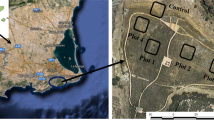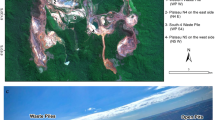Abstract
Purpose
Metal mining is the main cause of soil contamination caused by heavy metals. Mine tailings and minespoils generally offer hostile environments for plant growth due to their low nutrient availability, low organic matter content, and high trace metal content. This study was carried out with the aim of characterizing the soils that have developed on the tailings from an abandoned lead and zinc mine in Galicia (NW Spain) and determining the soil factors that limit revegetation.
Materials and methods
We selected three zones: (a) the minespoils, (b) in the mining area, and (c) the settling pond, where the sludge from the flotation process was deposited. A control soil was also sampled outside of the mining area. We analyzed the physicochemical properties and metal levels in the mine spoil and soil samples we collected.
Results and discussion
The results indicate that the main physical limitations of minesoils are their low effective depth, high porosity and stoniness, while the main chemical limitations are low organic matter content and low CEC and an imbalance between exchangeable cations. These minesoils are strongly affected by high Zn and Pb levels which hinder revegetation.
Conclusions
As high concentrations of toxic trace elements and a high pH are important factors in limiting the plant growth, the restoration procedure must overcome the oxidation processes by adding organic amendments that also contribute towards fixing heavy metals or by implanting spontaneous vegetation adapted to the mine conditions, such as common broom (Cytisus scoparius) or white birch (Betula celtiberica).

Similar content being viewed by others
References
Álvarez E, Fernández Marcos ML, Vaamonde C, Fernández-Sanjurjo MJ (2003) Heavy metals in the dump of an abandoned mine in Galicia (NW Spain) and in the spontaneously occurring vegetation. Sci Total Environ 313:185–197. doi:10.1016/S0048-9697(03)00261-4
Anawar HM, Canha N, Santa-Regina I, Freitas MC (2013) Adaptation, tolerance, and evolution of plant species in a pyrite mine in response to contamination level and properties of mine tailings: sustainable rehabilitation. J Soils Sediments 13:730–741. doi:10.1007/s11368-012-0641-7
Andrade L, Alonso Vega F, Marcet P, Fernández Covelo E (2005) Heavy metal contents of soils from semiarid Pampa, Buenos Aires Province (Argentina). In: Faz Cano A, Ortiz R., Mermut AR (eds.) Sustainable use and management of soils-arid and semiarid regions-advances in geoecology 36. A Cooperating Series of the International Union of Soil Science (IUSS) Catena Verlag. Germany. pp 477-492
Antonsiewicz DM, Escude-Duran C, Wierzbowska E, Sklodowska A (2008) Indigenous plant species with potential for the phytoremediation of arsenic and metal contaminated soil. Water Air Soil Pollut 193:197–210. doi:10.1007/s11270-008-9683-2
Arias Prieto D (1991) La caracterización geoquímica y mineralógica del yacimiento de Pb-Zn de Rubiais (Lugo-España). Laboratorio Xeolóxico de Laxe. Serie NOVA TERRA. Área de Xeoloxía e Minería do Seminario de Estudos Galegos, O Castro (in Spanish)
Aslibekian O, Moles R (2003) Environmental risk assessment of metals contaminated soils at silvermines abandoned mine site, Co Tipperary, Ireland. Environ Geochem Health 25(2):247–266. doi:10.1023/A:1023251102402
Batista MJ, Abreu MM, Serrano M (2007) Biogeochemistry in Neves-Corvo mining area, Iberian Pyrite Belt, Portugal. J Geochem Explor 92:159–176. doi:10.1016/j.gexplo.2006.08.004
Becerra-Castro C, Monterroso C, Prieto-Fernández A, Rodríguez-Lamas L, Loureiro-Viñas M, Acea MJ, Kidd PS (2012) Pseudometallophytes colonising Pb/Zn mine tailings: a description of the plant-microorganism-rhizosphere soil system and isolation of metal tolerant bacteria. J Hazard Mater 217–218:350–359. doi:10.1016/j.jhazmat.2012.03.039
Berg WA (1973) Evaluation of P and K soil fertility tests on coal mine spoils. In: Hutnik RJ, Daviss G (eds) Ecology and reclamation of devastated land, vol I, Gordon and Breach. New York, USA, pp 93–103
Bremner JM, Mulvaney CS (1982) Nitrogen-total. In: Page AL, Miller RH, Keeney RS (eds) Method of soil analysis: part 2. Chemical and microbiological properties. Agronomy monographs no. 9, 2nd edn. American Society of Agronomy and Soil Science Society of America, Madison, pp 595–624
Buol SW, Sanchez PA, Cate RB, Granger MA (1975) Soil fertility capability classification. In: Bornemizza E, Alvarado A (eds) Soil management in Tropical America. North Carolina State University, Raleigh, pp 126–145
Carballeira A, Devesa C, Retuerto R, Santillán E, Ucieda F (1983) Bioclimatología de Galicia, Fundación Pedro Barrié de la Maza, Conde de Fenosa, A Coruña (in Spanish)
Chung FH (1974) Quantitative interpretation of X-ray diffraction patterns. I. Matrix-flushing method of quantitative multicomponent analysis. J Appl Crystallogr 7:513–519. doi:10.1107/S0021889874010375
Cidu R (2011) Mobility of aqueous contaminants at abandoned mining sites: insights from case studies in Sardinia with implications for remediation. Environ Earth Sci 64:503–512. doi:10.1007/s12665-010-0874-y
Clemente R, Almela C, Bernal PM (2006) A remediation strategy based on active phytoremediation followed by natural attenuation in a soil contaminated by pyrite waste. Environ Pollut 143(3):397–406. doi:10.1016/j.envpol.2005.12.01
Decreto 60/2009, de 26 de febrero, sobre suelos potencialmente contaminados y procedimiento para la declaración de suelos contaminados. Consellería de Medio Ambiente e Desenvolvemento Sostible. Diario Oficial de Galicia, 24 Marzo 2009, 5920–5936 (in Spanish)
Diez Lázaro FJ (2008) Fitocorrección de suelos contaminados con metales pesados: Evaluación de plantas tolerantes y optimización del proceso mediante prácticas agronómicas. PhD thesis, Universidade de Santiago De Compostela, España (in Spanish)
Dudka S, Adriano DC (1997) Environmental impacts of metal ore mining and processing: a review. J Environ Qual 26:590–602. doi:10.2134/jeq1997.00472425002600030003x
Eriksson CP, Holmgren P (1996) Estimating stone and boulder contents in forest soils—evaluating the potential of surface penetration methods. Catena 28:121–134
Expert Panel on Soil (2003) Manual on methods and criteria for harmonized sampling, assessment monitoring and analysis of the effects of air pollution on forests. Part IIIa, Sampling and analysis of soil. Int. co-operative programme on assessment and monitoring of air pollution effects on forests. Institute for Forestry and Game Management, Belgium. http://www.inbo.be/docupload/2922.pdf Accessed 28 Nov 2012
FAO (2006) Guidelines for soil description. Food and Agriculture Organization of the United Nations, Rome
Fernández-Caliani JC, Barba-Brioso C, González I, Galán E (2009) Heavy metal pollution in soils around the abandoned mine sites of the Iberian Pyrite Belt (Southwest Spain). Water Air Soil Pollut 200:211–226. doi:10.1007/s11270-008-9905-7
Gee GW, Bauder JW (1986) Particle-size Analysis. In: Klute A (ed) Methods of soil analysis. SSSA, Madison, pp 383–411
Grandlic CJ, Mendez MO, Chorover J, Machado B, Maier RM (2008) Plant growth-promoting bacteria for phytostabilization of mine tailings. Environ Sci Technol 42:2079–2084. doi:10.1021/es072013j
Guitián F, Carballas T (1976) Técnicas de análisis de suelos. Editorial Pico Sacro, Santiago de Compostela (in Spanish)
Ha NTH, Sakakibara M, Sano S, Nhuan MT (2011) Uptake of metals and metaloids by plants growing in a lead-zinc mine area, Northern Vietnam. J Hazard Mater 186:1384–1391. doi:10.1016/j.jhazmat.2010.12.020
Hendershot WH, Duquette M (1986) A simple barium chloride method for determining cation exchange capacity and exchangeable cations. Soil Sci Soc Am J 50:605–608. doi:10.2136/sssaj1986.03615995005000030013x
Hons FM, Hossner LR (1980) Soil nitrogen relationships in spoil material generated in the surface mining of lignite coal. Soil Sci 129:222–228
Houba VJG, Temminghoff EJM, Gaikhorst GA, Van Vark W (2000) Soil analysis procedures using 0.01 M calcium chloride as extraction reagent. Commun Soil Sci Plant Anal 31(9–10):1299–1396. doi:10.1080/00103620009370514
Kabata-Pendias A, Pendias H (2000) Trace elements in soils and plants. CRC Press LLC, Boca Raton
Lindsay WL, Norwell WA (1978) Development of a DTPA soil test for zinc, iron, manganese and copper. Soil Sci Soc Am J 42:421–428. doi:10.2136/sssaj1978.03615995004200030009x
López-Ritas J, López Mélida J (1985) El Diagnóstico de Suelos y Plantas. Mundi-Prensa, Madrid (in Spanish)
Ma Y, Prasad MN, Rajkumar M, Freitas H (2011) Plant growth promoting rhizobacteria and endophytes accelerate phytoremediation of metalliferous soils. Biotechnol Adv 29(2):248–258. doi:10.1016/j.biotechadv.2010.12.001
Macías F, Calvo de Anta R (1983) El análisis del medio físico y su aplicación a la ordenación del territorio: una experiencia piloto en el área de Padrón (La Coruña). Trabajos Compostelanos de Biología 10:179–208 (in Spanish)
Macías F, Calvo de Anta R (2009) Niveles Genéricos de Referencia de Metales Pesados y otros elementos de traza en suelos de Galicia. Xunta de Galicia 2009. Santiago de Compostela, España (in Spanish)
Mehlich A (1984) Mehlich 3 soil test extractant: a modification of Mehlich 2 extractant. Commun Soil Sci Plant Anal 15(12):1409–1416. doi:10.1080/00103628409367568
Mendez MO, Maier RM (2008) Phytoremediation of mine tailings in temperate and arid environments. Rev Environ Sci and Biotechnol 7:47–59. doi:10.1007/s11157-007-9125-4
Munsell Color Co. (2000) Munsell soil color charts. Munsell Color Company, Baltimore
Power JF, Bond JJ, Sandoval FM, Willis WO (1974) Nitrification in Paleocene shale. Science 183:1077–1079. doi:10.1126/science.183.4129.1077
Prasad MNV, Freitas HM (2003) Metal hyperaccumulation in plants-biodiversity prospecting for phytoremediation technology. Electron J Biotechn 6:285–321. doi:10.2225/vol6-issue3-fulltext-6
Raizada A, Juyal GP (2012) Tree species diversity, species regeneration and biological productivity of seeded Acacia catechu wild. In rehabilitated limestone mines in the north west Indian Himalayas. Land Degrad Develop 23:167–174. doi:10.1002/ldr.1067
Roy M, McDonald LM (2013) Metal uptake in plants and health risk assessments in metal-contaminated smelter soils. Land Degrad Develop. doi:10.1002/ldr.2237
Schoenholtz SH, Van Miegroet H, Burger JA (2000) A review of chemical and physical properties as indicators of forest soil quality: challenges and opportunities. Forest Ecol Manag 138:335–356. doi:10.1016/S0378-1127(00)00423-0
SIGPAC (2009) Sistema de Información Geográfica de Parcelas Agrícolas. Ministerio de Agricultura Pesca y Alimentación. http://www.mapa.es/es/sig/pags/sigpac/intro.htm Accessed 14 Jan 2013
Soil Quality Institute (1999) Soil quality test kit guide. USDA-ARS and USDA-NRCS. http://soils.usda.gov/sqi/assessment/test_kit.html Accessed 1 Apr 2013
Vega FA, Covelo EF, Andrade ML, Marcet P (2004) Relationships between heavy metals content and soil properties in minesoils. Anal Chim Acta 524:141–150. doi:10.1016/j.aca.2004.06.073
Vega FA, Covelo EF, Andrade ML (2005) Limiting factors for reforestation of mine spoils from Galicia (Spain). Land Degrad Develop 16:27–36. doi:10.1002/ldr.642
Wong MH (2003) Ecological restoration of mine degraded soils, with emphasis on metal contaminated soils. Chemosphere 50(6):775–780. doi:10.1016/S0045-6535(02)00232-1
Wong JWC, Ip CM, Wong MH (1998) Acid-forming capacity of lead–zinc mine tailings and its implications for mine rehabilitation. Environ Geochem Health 20:149–155. doi:10.1023/A:1006589124204
Wu SC, Cheung KC, Luo YM, Wong MH (2006) Effects of inoculation of plant growth-promoting rhizobacteria on metal uptake by Brassica juncea. Environ Pollut 140:124–135. doi:10.1016/j.envpol.2005.06.02
Acknowledgments
This study was supported by Project EM2013/018 (Xunta de Galicia). Vega, FA and Arenas-Lago, D are grateful to the Ministry of Science and Innovation and the University of Vigo for the Ramón y Cajal and FPI-MICINN grants, respectively.
Author information
Authors and Affiliations
Corresponding author
Additional information
Responsible editor: Claudio Bini
Rights and permissions
About this article
Cite this article
Rodríguez-Seijo, A., Arenas-Lago, D., Lago-Vila, M. et al. Limitations for revegetation in lead/zinc minesoils (NW Spain). J Soils Sediments 14, 785–793 (2014). https://doi.org/10.1007/s11368-013-0826-8
Received:
Accepted:
Published:
Issue Date:
DOI: https://doi.org/10.1007/s11368-013-0826-8




